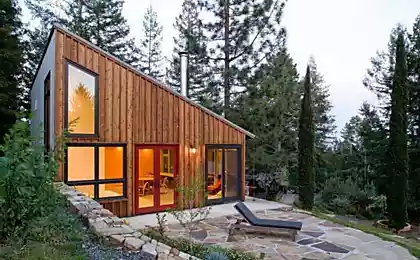181
What to do with the sewer so that it does not freeze over in winter
Sewerage installation is one of the most important elements of the construction process. This topic may be somewhat sensitive for someone, but do not lose sight of it. Even if Repair in the country or in a private house is done with their own hands. It is necessary to take into account all the nuances of laying sewers, so that in the future a lot of problems will not be discovered. Especially in the cold. So how should the sewer be located under the house so that it is not afraid of any cold? We looked into it.

Why is special attention paid to sewage in the winter? The answer is simple. You need to choose the right depth of laying pipes to avoid possible freezing of drains and the formation of traffic jams there. This is winter: aggressive sub-zero temperatures, snow, icing. Anything can happen. In this weather, I would sit in a warm and cozy house and not show my nose from there. Not trying to figure out what's wrong with the drains and how to solve the problem.

Frost and sun - a problem day In construction, there is a value that helps to determine at what level you need to lay pipes. And not just sewers. This value is called the depth of freezing of the soil. Its meaning is to understand at what maximum depth the soil remains at around 0 degrees. Anything below this mark is considered safe for any pipe.
This is done in order to prevent freezing of pipes in the cold season. This is not just about the inconveniences associated with this phenomenon. Frozen pipe has a chance to collapse on its own and damage the foundation of the house, which may be located above it. Remember when drivers rushed to drain water from their old cars when they heard about the coming frosts? Frozen water can simply blow the pipe from the inside out. And that, in turn, due to such deformation, can damage, for example, the foundation of the house.

Sewerage under the house and in the cold and cold Building standards suggest that the pipes will be laid below the level of freezing soil. It's rational. But still there are brave people who circumvent this recommendation. And not always suffer from a destroyed foundation or pipes torn by ice. This is due to the proper installation of the entire sewer system. No wonder they say that a good sewer does not freeze.
You can decide on such laying of sewer pipes only by adequately assessing whether all building parameters are normal. Will they work in the event of critical temperatures in winter? In any case, you need to know the indicator of soil freezing for your territory and the specific type of soil that prevails in your region.

If the indicator of soil freezing allows you to lay the pipe a little higher than it should be, do it. But in this case, you need to adhere to the following tricks to prevent a deplorable situation. The sewer pipe can be insulated with special materials. Just in case of extremely low temperatures. This will help keep the pipes safe and sound.
Try to think about the location of the sewer pipes, which would not involve too sharp turns. It is better when sewage goes through the pipes spontaneously. This factor will also prevent the pipe from freezing in winter. In addition, such sewers have less risk of blockage formation. Choose the right pipe diameter. It should also contribute to the rapid outflow of liquids through the drain.

If you adhere to all these popular rules and tips, the sewer will work like a clock. This is greatly facilitated by the diameter of the pipes. After all, in a large pipe, it is unlikely that something will freeze if the liquid there is constantly in motion. Provided that the drains are located correctly and allow sewage to flow independently through the pipes. This will turn the sewer into a mechanism with uninterrupted activity. It will also be a guarantee of its normal functioning.

Of course, the masters of all trades can have their own view of such a situation. And that's good, After all, the more competent opinions, the easier it is for beginners to get invaluable experience. and deal with the problem on their own. Do not be afraid to experiment and take responsibility for your own experiments. And you're gonna make it!

Why is special attention paid to sewage in the winter? The answer is simple. You need to choose the right depth of laying pipes to avoid possible freezing of drains and the formation of traffic jams there. This is winter: aggressive sub-zero temperatures, snow, icing. Anything can happen. In this weather, I would sit in a warm and cozy house and not show my nose from there. Not trying to figure out what's wrong with the drains and how to solve the problem.

Frost and sun - a problem day In construction, there is a value that helps to determine at what level you need to lay pipes. And not just sewers. This value is called the depth of freezing of the soil. Its meaning is to understand at what maximum depth the soil remains at around 0 degrees. Anything below this mark is considered safe for any pipe.
This is done in order to prevent freezing of pipes in the cold season. This is not just about the inconveniences associated with this phenomenon. Frozen pipe has a chance to collapse on its own and damage the foundation of the house, which may be located above it. Remember when drivers rushed to drain water from their old cars when they heard about the coming frosts? Frozen water can simply blow the pipe from the inside out. And that, in turn, due to such deformation, can damage, for example, the foundation of the house.

Sewerage under the house and in the cold and cold Building standards suggest that the pipes will be laid below the level of freezing soil. It's rational. But still there are brave people who circumvent this recommendation. And not always suffer from a destroyed foundation or pipes torn by ice. This is due to the proper installation of the entire sewer system. No wonder they say that a good sewer does not freeze.
You can decide on such laying of sewer pipes only by adequately assessing whether all building parameters are normal. Will they work in the event of critical temperatures in winter? In any case, you need to know the indicator of soil freezing for your territory and the specific type of soil that prevails in your region.

If the indicator of soil freezing allows you to lay the pipe a little higher than it should be, do it. But in this case, you need to adhere to the following tricks to prevent a deplorable situation. The sewer pipe can be insulated with special materials. Just in case of extremely low temperatures. This will help keep the pipes safe and sound.
Try to think about the location of the sewer pipes, which would not involve too sharp turns. It is better when sewage goes through the pipes spontaneously. This factor will also prevent the pipe from freezing in winter. In addition, such sewers have less risk of blockage formation. Choose the right pipe diameter. It should also contribute to the rapid outflow of liquids through the drain.

If you adhere to all these popular rules and tips, the sewer will work like a clock. This is greatly facilitated by the diameter of the pipes. After all, in a large pipe, it is unlikely that something will freeze if the liquid there is constantly in motion. Provided that the drains are located correctly and allow sewage to flow independently through the pipes. This will turn the sewer into a mechanism with uninterrupted activity. It will also be a guarantee of its normal functioning.

Of course, the masters of all trades can have their own view of such a situation. And that's good, After all, the more competent opinions, the easier it is for beginners to get invaluable experience. and deal with the problem on their own. Do not be afraid to experiment and take responsibility for your own experiments. And you're gonna make it!
How to quickly cook some details without running around the shops
Five years ago I brought a classic recipe for onion soup from Paris.























